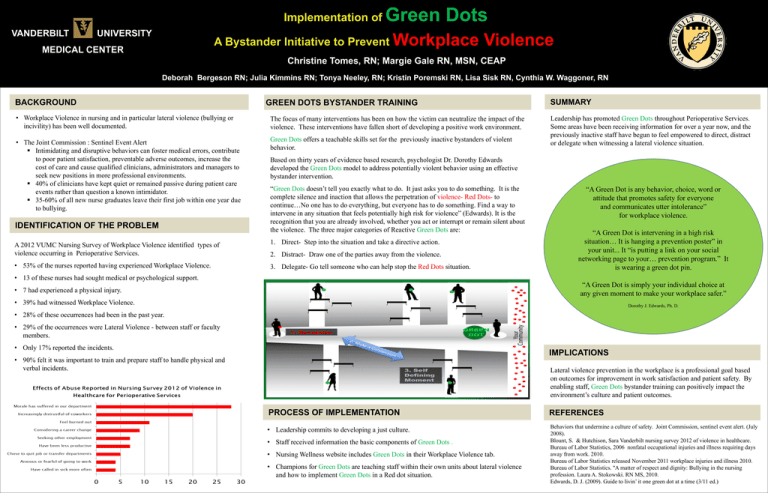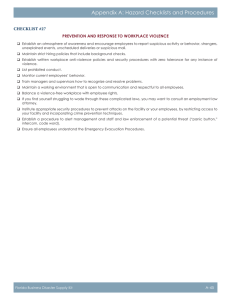Green Dots Workplace Violence Implementation of
advertisement

Implementation of VANDERBILT UNIVERSITY Green Dots A Bystander Initiative to Prevent Workplace MEDICAL CENTER Violence Christine Tomes, RN; Margie Gale RN, MSN, CEAP Deborah Bergeson RN; Julia Kimmins RN; Tonya Neeley, RN; Kristin Poremski RN, Lisa Sisk RN, Cynthia W. Waggoner, RN BACKGROUND GREEN DOTS BYSTANDER TRAINING • Workplace Violence in nursing and in particular lateral violence (bullying or incivility) has been well documented. The focus of many interventions has been on how the victim can neutralize the impact of the violence. These interventions have fallen short of developing a positive work environment. • The Joint Commission : Sentinel Event Alert Intimidating and disruptive behaviors can foster medical errors, contribute to poor patient satisfaction, preventable adverse outcomes, increase the cost of care and cause qualified clinicians, administrators and managers to seek new positions in more professional environments. 40% of clinicians have kept quiet or remained passive during patient care events rather than question a known intimidator. 35-60% of all new nurse graduates leave their first job within one year due to bullying. Green Dots offers a teachable skills set for the previously inactive bystanders of violent behavior. IDENTIFICATION OF THE PROBLEM SUMMARY Leadership has promoted Green Dots throughout Perioperative Services. Some areas have been receiving information for over a year now, and the previously inactive staff have begun to feel empowered to direct, distract or delegate when witnessing a lateral violence situation. Based on thirty years of evidence based research, psychologist Dr. Dorothy Edwards developed the Green Dots model to address potentially violent behavior using an effective bystander intervention. “Green Dots doesn’t tell you exactly what to do. It just asks you to do something. It is the complete silence and inaction that allows the perpetration of violence- Red Dots- to continue…No one has to do everything, but everyone has to do something. Find a way to intervene in any situation that feels potentially high risk for violence” (Edwards). It is the recognition that you are already involved, whether you act or interrupt or remain silent about the violence. The three major categories of Reactive Green Dots are: A 2012 VUMC Nursing Survey of Workplace Violence identified types of violence occurring in Perioperative Services. 1. Direct- Step into the situation and take a directive action. • 53% of the nurses reported having experienced Workplace Violence. 3. Delegate- Go tell someone who can help stop the Red Dots situation. 2. Distract- Draw one of the parties away from the violence. • 13 of these nurses had sought medical or psychological support. “A Green Dot is any behavior, choice, word or attitude that promotes safety for everyone and communicates utter intolerance” for workplace violence. “A Green Dot is intervening in a high risk situation… It is hanging a prevention poster” in your unit... It “is putting a link on your social networking page to your… prevention program.” It is wearing a green dot pin. “A Green Dot is simply your individual choice at any given moment to make your workplace safer.” • 7 had experienced a physical injury. • 39% had witnessed Workplace Violence. Dorothy J. Edwards, Ph. D. • 28% of these occurrences had been in the past year. • 29% of the occurrences were Lateral Violence - between staff or faculty members. • Only 17% reported the incidents. IMPLICATIONS • 90% felt it was important to train and prepare staff to handle physical and verbal incidents. Lateral violence prevention in the workplace is a professional goal based on outcomes for improvement in work satisfaction and patient safety. By enabling staff, Green Dots bystander training can positively impact the environment’s culture and patient outcomes. PROCESS OF IMPLEMENTATION REFERENCES • Leadership commits to developing a just culture. Behaviors that undermine a culture of safety. Joint Commission, sentinel event alert. (July 2008). Blount, S. & Hutchison, Sara Vanderbilt nursing survey 2012 of violence in healthcare. Bureau of Labor Statistics, 2006 nonfatal occupational injuries and illness requiring days away from work. 2010. Bureau of Labor Statistics released November 2011 workplace injuries and illness 2010. Bureau of Labor Statistics. ''A matter of respect and dignity: Bullying in the nursing profession. Laura A. Stokowski. RN MS, 2010. Edwards, D. J. (2009). Guide to livin’ it one green dot at a time (3/11 ed.) • Staff received information the basic components of Green Dots . • Nursing Wellness website includes Green Dots in their Workplace Violence tab. • Champions for Green Dots are teaching staff within their own units about lateral violence and how to implement Green Dots in a Red dot situation.

